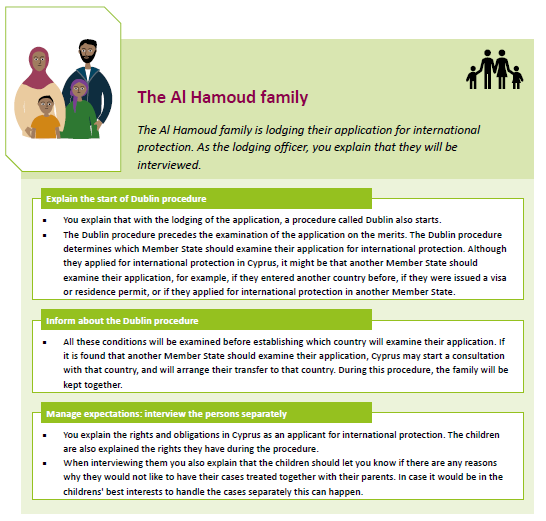When a third-country national or stateless person lodges an application for international protection in a Member States, that Member State has to assess which Member State is responsible for examining the application. The ground rule of the Common European Asylum System (CEAS) is that Member States have to examine any application for international protection lodged by third-country nationals or stateless persons within the territory of the Member States. The application will be examined by a single Member State.
The mandatory procedure to determine the Member State responsible for examining an application for international protection lodged in a Member State is set out in the Dublin III regulation. This procedure describes the criteria that should be applied for deciding which Member State shall examine the application.
All third-country nationals and stateless persons asking for international protection, as well as persons apprehended for illegal stay in a Member State but who have previously applied for international protection in another Member State, may be subject to the Dublin III regulation. It is therefore important that they are provided with information on the Dublin procedure at an early stage.
Key information to provide on initial contact
Basic information on the Dublin System and the CEAS.
Even before the lodging of an application, the applicant should be informed that the Dublin III regulation sets out the criteria and mechanisms determining which Member State is responsible for examining their application and that they cannot choose which Member State will be responsible for this.
All Member States are bound by rules agreed on an EU level or apply similar national rules.
All Member States are bound by the rules agreed at EU level or apply similar national rules with regards to the rights of the applicant on things such as accommodation and other basic needs, and with regards to the obligations of the applicant. Furthermore, it is important that the applicant cooperate with the authorities. Absconding or damaging one’s documents will not benefit the procedure and will not help the applicant avoid the determination process. Informing applicants of their right to access NGOs, interpretation, etc. is also a good way of building trust.
Does the applicant have family members in another Member State?
The Dublin III regulation can be applied to reunite the applicant with their family. It is therefore important that they gather and provide evidence to prove their family link. Explain, under the Dublin III regulation, who is considered a family member, and in the case of an unaccompanied minor, who is considered a relative. Also mention that both parties will need to consent in writing to be reunited. Inform about the opportunity for applicants to be reunited with specific persons if they are either dependent on these persons, or if the persons concerned are depending on the assistance of the applicant.
Does the applicant not have family members in a Member State? An issued residence permit, a visa, a border crossing or stay in a specific country can affect which country is responsible.
If they have any documents or elements that can serve as evidence with regards to entry, stay or residence they should gather this and present them to the authorities.
Is the applicant a vulnerable person? inform them of the specific safeguards and guarantees that may apply.
Children should be informed that the best interest of the child is a primary consideration of Member States when applying the Dublin III regulation and that an unaccompanied minor will have the right to a representative. If the applicant has a vulnerability, let them know that they are entitled to specific safeguards and guarantees, and how to access these.
Persons apprehended for illegal stay
In these cases, it is important to inform the person of their situation, and the next steps of the authorities. If there are indications that a person might wish to apply for international protection, they should be provided with the relevant information on how to do this, and on how they can access independent legal counselling.
If the person does not wish to apply for international protection in the Member State where they are currently present, they might still be subject to the Dublin III regulation if they have already lodged an application for international protection in another Member State.
Character: Svetlana
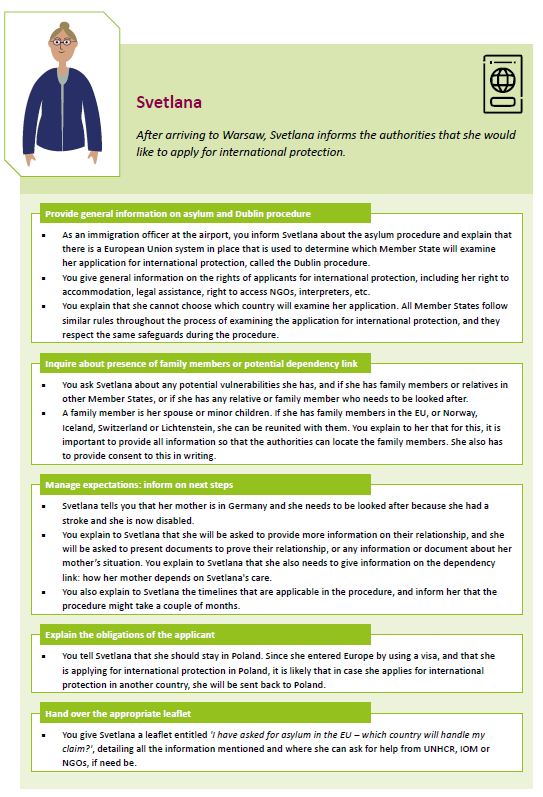
Character: Mahmoud
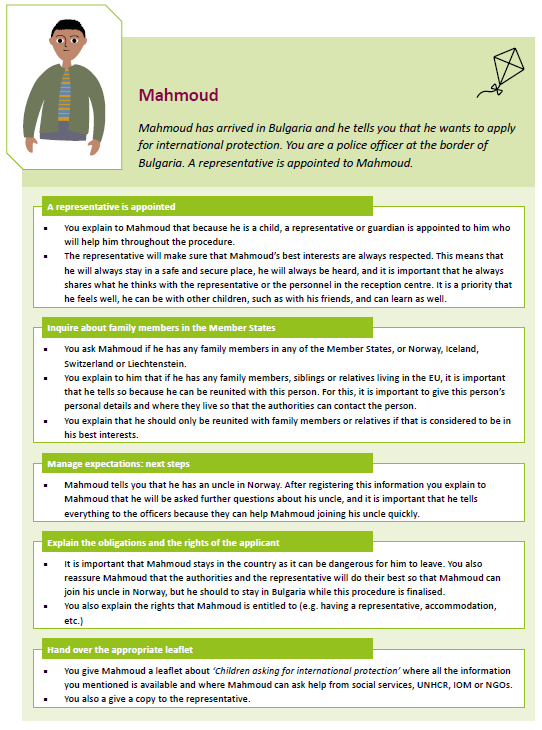
Fingerprinting in this context is regulated by the Eurodac II regulation, which also prescribes the information that authorities must provide in these cases, and minimum standards on how to provide it.
Information on fingerprinting should be provided when fingerprints are taken. Persons that have been found illegally staying within the territory of the Member States must be provided information no later than at the time when the data relating to that person is transmitted to the Central System.
Applicants, third-country nationals, and stateless persons found to be illegally staying on the territory of the Member States are not always fingerprinted. This depends on the way the national procedure is designed. Fingerprinting of applicants can be postponed or extended for certain reasons and may take place at a later stage.
Information on fingerprinting must be:
■ concise, transparent, comprehensible and in an easily accessible format;
■ written in clear and plain language, adapting this to the needs of vulnerable persons, such as children;
■ provided, where necessary, orally;
■ in a language that the person understands or can reasonably be expected to understand.
Key information to provide on fingerprinting
Before fingerprinting, make sure that the applicant understands what a fingerprint is.
We all have unique individual fingerprints and pictures of these can be used to identify us. Fingerprinting is compulsory for persons of age 14 or older that ask for international protection in the Member States, are apprehended in connection with irregular border crossing or are found to be illegally staying within the territory of the Member States. Fingerprints must be taken and checked even though the applicant has family or relatives in another Member State that they want to be reunited with.
Explain what will happen with their fingerprints.
Applicant’s fingerprints are transmitted to a database called ‘Eurodac’. The applicant should be informed that Eurodac is an EU fingerprint database that allows Member States to compare the fingerprints of applicants for international protection and persons found to be illegally staying within the territory of the Member States. This makes it easier for Member States to determine which country should be responsible for examining an application.
Inform that the fingerprints will be checked by the authorities.
Member States check fingerprints to see if an applicant has applied for international protection before or if the applicant has been fingerprinted at a border. The fingerprints may also be checked against the Visa Information System (VIS), which is a database that contains information on visas granted within the Schengen area.
Explain that fingerprints of all of their fingers, their gender, the country taking the fingerprint and (if applicable) the place and date of their application will be stored.
If they have asked for international protection, the fingerprints will be stored for 10 years. If the applicant has been fingerprinted following an irregular entry the fingerprints will be kept for 18 months. After this period the data is automatically deleted by the system. Data of persons found illegally staying on the territory will not be stored.
Inform that their data can be accessed by the authorities that are determining which Member State will be responsible for examining their application for international protection.
Under strict conditions, the police and the European Police Office (Europol) may also access the data, if they are investigating serious crimes.
The information will never be shared with the country of origin of the applicant.
Inform on data protection.
Applicant’s have a right to access the data, obtain a copy of the data as well as to correct and/or delete the data if there are any mistakes. Inform the applicant of how they can exercise these rights in your country.
Who is fingerprinted?
A third-country national or stateless person who is 14 years and older will be fingerprinted, if they:
apply for international protection,
are apprehended in connection with an irregular crossing of an external border, or
are found illegally staying on the territory of a Member State
Good practice: provide a copy of the Eurodac data
Providing a copy of the Eurodac data to the applicant can help them exercise their rights to access and, if needed, to delete and correct the data. Explain to the applicant that this is not a copy of their application for international protection.
Leaflet developed by the EU Fundamental Rights Agency
In 2019, the Fundamental Rights Agency (FRA) developed a leaflet entitled Right to information – Guide for authorities when taking fingerprints for EURODAC to assist officers and authorities to inform applicants for international protection and migrants in an understandable and accessible way about the processing of their fingerprints in Eurodac.
The leaflet specifies what information should be provided to applicants, how to provide it and gives some special considerations for informing children.
The leaflet may be consulted and downloaded through this link.
Good practice: fingerprinting after irregular crossing of the external border
When fingerprints are taken of third country nationals in connection with the irregular crossing of an external border, make sure to inform them that if they later decide to apply for international protection in another Member State they may be returned to your Member State in order for their application to be examined even if they did not apply for international protection in your Member State.
Character: Bakary
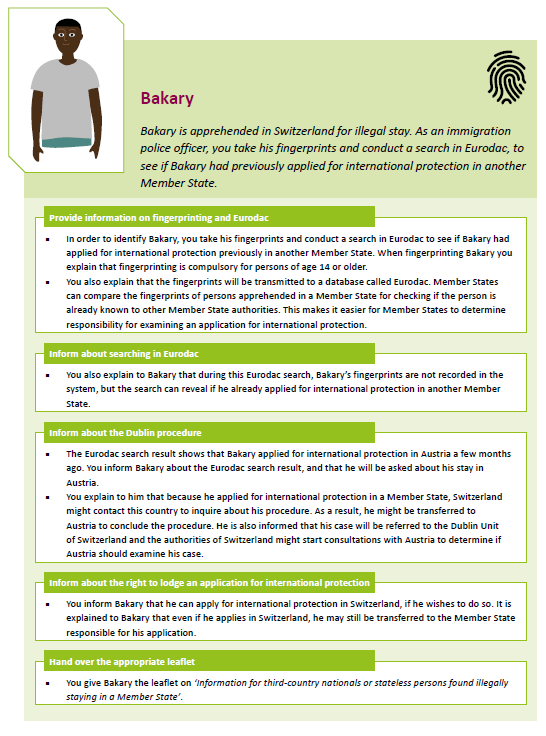
Character: Al Hamoud family
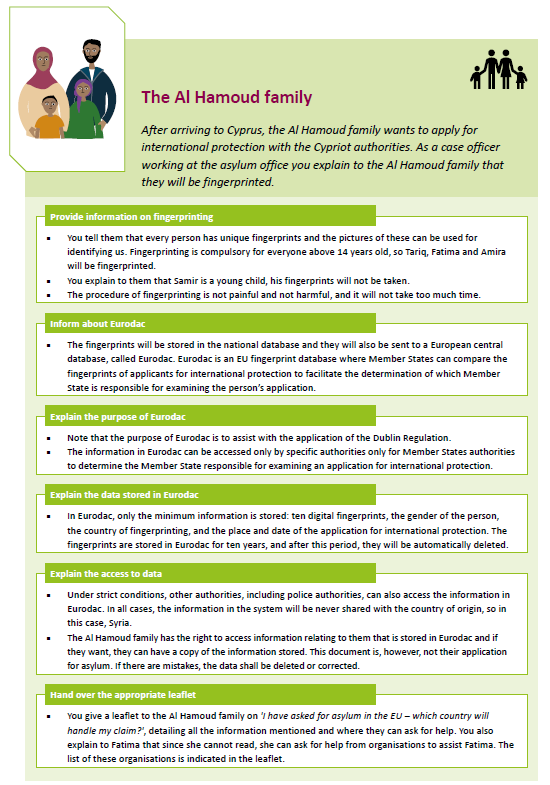
When a person lodges an application for international protection, they will need to be thoroughly informed about the asylum procedure, reception conditions, their rights and obligations, etc. This practical guide will only cover the information needs specific to the Dublin procedure. Article 4 Dublin III regulation sets out the information that must be provided to the applicant as soon as an application is lodged. This information is contained within the common leaflets annexed to the implementing regulation. It should be noted that there is a common leaflet for adults and one for unaccompanied minors.
The Dublin III regulation provides for a specific Dublin interview. In some Member States, this interview is combined with the registration and lodging of the application. In others, it happens a bit later in the procedure.
Key information to provide when the applicant lodges their application
Article 4 Dublin III regulation provides clear instructions on the information that must be provided at this stage.
The objectives of the Dublin III regulation
Inform the applicant about the consequences of making another application in a different Member State. An application for international protection lodged in one Member State can result in that Member State voluntarily taking responsibility under the Dublin III regulation. Provide some information about the Dublin personal interview, if this interview takes place at a later stage of the procedure.
The criteria for determining the Member State responsible
Inform the applicant of the hierarchy of these criteria and the different steps of the procedure and their duration. Explain the consequences of moving from one Member State to another during the phases in which the Member State responsible is being determined and the application for international protection is being examined.
Family members (or relatives) in other Member States
Inform the applicant about the importance of submitting information regarding the presence of family members, relatives or any other family relations in the Member States as well as the timelines within which a take charge request would need to be submitted. In addition, encourage the applicant to inform the Member State about whether the applicant is dependent on any of those family members, relatives or family relations or if any of those depend on the applicant. Finally, inform about the practical means through which they can submit such information if it is not immediately available to the applicant.
The possibility to receive assistance from NGOs and other organisations
Informing the applicant about this can help to build trust. Such information could include the possibility to access independent legal assistance that can help the applicant navigate the procedure, collect information, and prepare for the Dublin interview.
The exchange of data between Member States
Inform the applicant that Member States can exchange data on them for the purpose of examining the application for international protection, determining the Member State responsible, or implementing their obligations under the Dublin III regulation. The applicant has the right to access data relating to them and to request that such data be corrected if inaccurate or be deleted if unlawfully processed.
The procedures for exercising the rights regarding their personal data
In addition, inform the applicant on the contact details of the competent authorities and of the national data protection authorities responsible for hearing claims concerning the protection of personal data.
The right to challenge and appeal a decision
Inform the applicant that if they do not agree with a decision to transfer them to the Member State that is determined as responsible, they have the possibility to challenge a transfer decision, and, where applicable, to apply for a suspension of the transfer, pending the outcome of the appeal or review. Furthermore, inform the applicant that they have the right to legal assistance with regards to the appeal.
Lodging an application for international protection and the Dublin III regulation
The CEAS makes a difference between the making, registering, and lodging of an application for international protection. You can find more information on this topic in the EASO-Frontex Practical Guide: Access to the asylum procedure (p. 4). The Member States have organised their procedures in slightly different ways and as such it is important to be familiar with the procedures in your Member State.
The Dublin procedure starts when the applicant lodges their application pursuant to Article 20(2) Dublin III regulation. Pursuant to that provision, an application is lodged once a form submitted by the applicant, or a report prepared by the authorities, has reached the competent authorities of the Member State concerned. Furthermore, according to the judgment of the Court of Justice of the European Union in case C-670/16, Mengesteab (3), ‘an application is deemed to have been lodged if a written document, prepared by a public authority and certifying that a third-country national has requested international protection, has reached the authority responsible for implementing the obligations arising from that regulation’. It is also deemed to have been lodged if only the main information contained in such a document, but not that document or a copy thereof, has reached that authority.
Explaining evidence from databases (Eurodac/VIS)
In Dublin cases based on 'entry and stay', the Dublin Unit often has evidence such as visas, residence permits or ‘hits’ from the Visa Information System or Eurodac. Dublin Units can use the presentation of these elements as part of the information provision and explain their relevance for determining the responsible Member State and the continued procedure. At the same time, it is also important to explain the family and dependency criteria that are relevant for family unity under the Dublin procedure to the applicant.
Common leaflets for applicants
The Dublin III regulation and the Eurodac II regulation require Member States to provide information to applicants using common leaflets annexed to the implementing regulation. Each leaflet has space for the national authorities to include relevant Member State specific information. The content of all of these leaflets is set out in annexes in the implementing regulation, see references below.
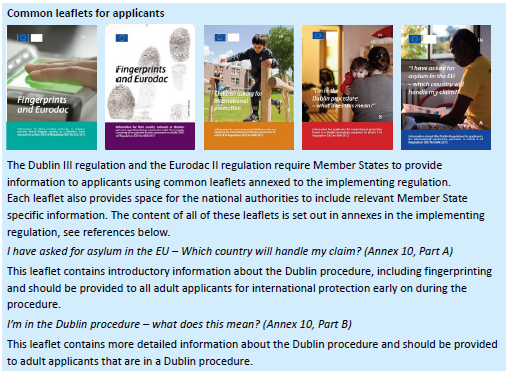
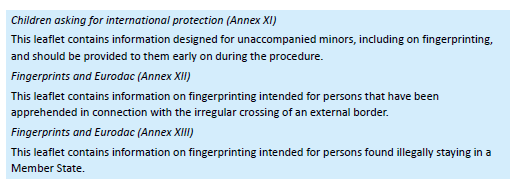
Character: Mahmoud
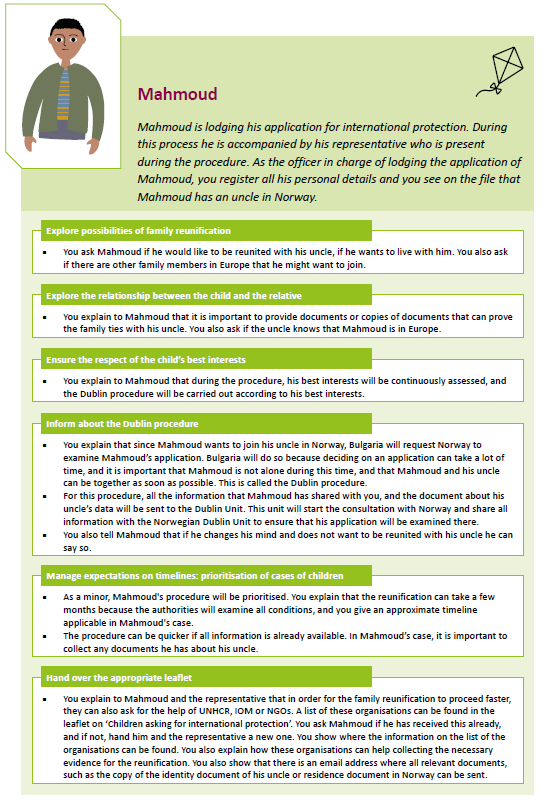
Character: Al Hamoud family
